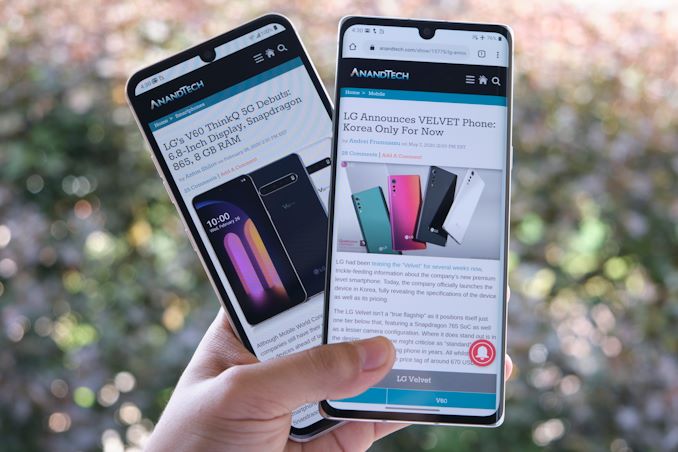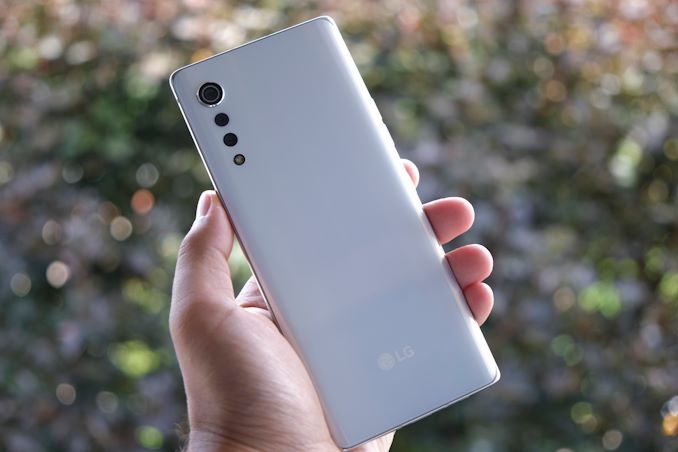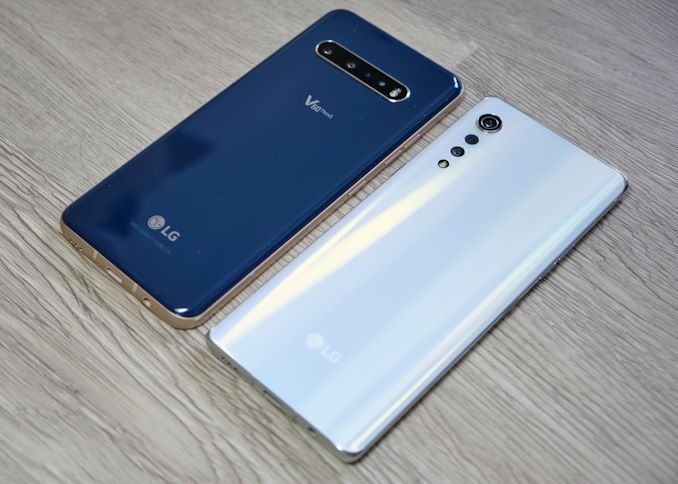The LG V60 and VELVET Review: A Classic & A Design Restart
by Andrei Frumusanu on July 15, 2020 9:00 AM EST
It’s been a few months since LG has released the LG V60, and since then the company has also finally managed to launch the new Velvet phone to western markets outside of Korea, such as Germany. The two new 2020 phones are quite contrasting devices for LG – representing what one could say the company’s classic design philosophy versus a newer, more refreshing design language. They’re also contrasting devices in terms of their specifications and positioning, with the V60 being a successor flagship devices with a high-end SoC, whilst the new Velvet is a “premium” design with the new Snapdragon 765, coming at a lower price point and some compromises in terms of specification – but not too many as to call it a mid-range phone.
Both phones are overdue a closer look, and that’s precisely what we’ll be doing today.
| LG 2020 Flagships | |||
| V60 | Velvet | ||
| SoC | Qualcomm Snapdragon 865 1x Cortex-A77 @ 2.84GHz 3x Cortex-A77 @ 2.42GHz 4x Cortex-A55 @ 1.80GHz |
Qualcomm Snapdragon 765 1x Kryo 475 (CA76) @ 2.3GHz 1x Kryo 475 (CA76) @ 2.2GHz 6x Kryo 475 (CA55) @ 1.8GHz |
|
| GPU | Adreno 650 @ 587MHz | Adreno 620 | |
| DRAM | 8 GB | 8 GB | |
| Storage | 128 GB UFS 2.1 +microSD |
128 GB UFS 2.1 +microSD |
|
| Display | 6.8" FullVision OLED 2460 x 1080 (20.5:9) |
6.8" FullVision OLED 2460 x 1080 (20.5:9) |
|
| Size | Height | 169.3 mm | 167.2 mm |
| Width | 77.6 mm | 74.1 mm | |
| Depth | 8.9 mm | 7.9 mm | |
| Weight | 218 grams | 180 grams | |
| Battery Capacity | 5000 mAh (Typical) | 4300 mAh (Typical) | |
| Wireless Charging | Qi | Qi | |
| Rear Cameras | |||
| Main | 64 MP 1/1.7" 0.8µm f/1.8 w/OIS |
48MP f/1.8 w/OIS |
|
| Wide | 13 MP 1/3.4" 1µm f/1.9 117° super-wide angle |
8MP Super-wide angle |
|
| Extra | ToF 1/4" 14µm f/1.9 117° super-wide angle |
5MP Depth |
|
| Front Camera | 10 MP 1/3.1" 1.22μm f/1.9 |
16MP | |
| I/O | USB 2.0 Type-C 3.5mm headphone jack Under-screen Fingerprint reader |
USB 2.0 Type-C 3.5mm headphone jack Under-screen Fingerprint reader |
|
| Wireless (local) | Wi-Fi 6 Bluetooth 5.1 |
Wi-Fi 6 Bluetooth 5.1 |
|
| Cellular | GSM, CDMA, HSPA, 4G/LTE, 5G | ||
| Splash, Water, Dust Resistance | IP68 | IP68 | |
| Dual-SIM | nano-SIM | nano-SIM | |
| Launch OS | Android 10 | Android 10 | |
| Launch Price | $899 | 599€ | |
In terms of specifications and the brains of the devices, as mentioned, the LG V60 is a familiar phone as it’s simply sporting the best of the best. The Snapdragon 865 features four Cortex-A77 cores, one of which clocks in at up to 2.84GHz and three others at up to 2.42GHz, paired with four low-power Cortex-A55 cores at 1.8GHz. We’ve seen excellent performance and power efficiency out of Qualcomm’s latest chipset in other 2020 flagship devices, and the LG V60 is pretty much in line with the pack in terms of performance and efficiency.
The LG Velvet on the other hand is amongst a smaller number of devices which make due with Qualcomm’s new Snapdragon 765 SoC. This “premium” model functionally has the same level of features as the flagship Snapdragon 865 SoC, but just comes at lower performance levels. In terms of IP, we find two Cortex A76 cores, one up to 2.3GHz and another up to 2.2GHz, paired with six low-power Cortex-A55 cores at 1.8GHz. The GPU in the form of the Adreno 620 is also smaller than the bigger brother’s Adreno 650 configuration.
What’s special about both these SoCs is that they’re 5G enabled. The LG V60 makes use of an external X55 modem for connectivity, while the Velvet integrates its modem capabilities inside of the Snapdragon 765.
Both phones feature 8GB of RAM (LPDDR5 for the V60 and LPDDR4X for the Velvet), and feature 128GB of storage, expandable via microSD slots.
In terms of designs, both phones are very different to each other. The one thing they share in common is the display specifications; both phones feature 6.8” 2460 x 1080 OLED displays. The resolution doesn’t surprise too much for the Velvet as it’s a lower priced phone, but it is quite weird to see LG go backwards on the V60, offering a downgrade from the 1440p resolutions of previous, smaller, V-series phones. There are battery life considerations here which we’ll discuss in more detail later, but it does stretch out quite a bit for displays of these sizes.
Both displays still make use of “dewdrop” notch designs and the cut-outs here are virtually identical between the two phones. The Velvet tries to smooth out the bezel corner near the cut-out via blacked out pixels, but other than that I wouldn’t be surprised if these were actually the same display panels.
Of course, the immediately visible difference between the two phones is their bezel designs. The V60 has a very classic look to it; a flat screen with some quite sizeable side bezels and a chamfered metal frame. The Velvet on the other hand is a lot more contemporary, employing a curved front screen design on its sides, with only a thin glossy metal frame.
You could argue that the V60 looks a lot more industrial, but for me the ergonomics of the Velvet are immeasurably better – it’s not only a physically narrower phone, but it just feels much better in hands thanks to its curvatures as well as thinner form-factor.
Despite the fact that the screen diagonals on both phones are identical, and maybe even have the same panels, the Velvet is a much handier phone. There’s also a big weight difference between the two units, as the V60 comes in at a hefty 218grams versus the Velvet’s 180g. Admittedly, the V60 uses a bigger 5000mAh battery whilst the Velvet is 14% smaller at 4300mAh (which is still respectable).
On the camera side of things, besides the SoC, it’s also where we see bigger differences between the two phones capabilities. The LG V60 has a new generation and larger 1/1.7” main camera sensor coming in with 64MP resolution, with a quad-Bayer colour filter layout binning down to 16MP in regular photos. LG uses this module’s high native resolution to achieve lossless 2x zooming – a necessity as the phone lacks a dedicated telephoto module.
The Velvet uses a similar method, albeit with a 48MP primary camera sensor that’s physically smaller in size than that of the V60’s.
In terms of ultra-wide-angle modules, the V60 features a 13MP sensor while the Velvet makes due with a mere 8MP unit. Besides price considerations, I think the Velvet might be limited by the thickness of the phone here and the deployable sensor sizes, as the phone lacks any protrusions with the UWA module sitting flush with the back glass panel (The main camera does have a small bump).
There’s also an extra ToF sensor on the V60, and unspecified 5MP depth sensor on the Velvet – both don’t actually serve as capturing modules but augment the capture abilities of the phones in modes such as portrait mode.
At the bottom of the phones, we see a similar setup of 3.5mm headphone jack, USB-C port and a three-holed bottom speaker setup (The top earpieces also serve as stereo speakers for playback). The fact that these phones still include the 3.5mm headphone jacks in 2020 makes them actually stand out to the rest of the competition who had opted to drop the useful connector in favour of profit making selling wireless audio accessories. Good on LG for sticking with their ethos.
Overall, the phones in terms of design are quite contrasting, and if you wouldn’t be familiar with them nor see their brandings, it would be hard to believe that they’re actually from the same company, released only a few months apart from each other. LG has had considerable trouble with the industrial design over the last few generations and the V60 is pretty much a continuation of that “outdated” look. The new Velvet is a fresh breath of air and I feel it actually belongs in 2020, its ergonomics are substantially better and the build quality is I feel higher than that of the V60, a bit ironic given that the two devices are positioned the other way around in terms of pricing and product categories.
















81 Comments
View All Comments
PeachNCream - Thursday, July 16, 2020 - link
Basically that Notebookcheck is better for comparing things to other things than Anandtech - which is true. If I want to kill time reading meandering articles about hardware I will never own, I read AT. If I want to research a product I actually do intend to buy, Notebookcheck is where I go first to get to the actual point.s.yu - Thursday, July 16, 2020 - link
Yup, with the exception that their battery tests are updated from time to time so you won't get apples to apples battery numbers between equivalent devices across generations, say S20 and S7, which was what psychobriggsy suggested.s.yu - Thursday, July 16, 2020 - link
lol, I don't get what you're not getting.ack68 - Wednesday, July 15, 2020 - link
I received two v60's free from AT&T when we switched from Sprint. Also received the dual screens for free as well. Using the dual screen all the time can kill your battery within 4hrs. The only irritating thing is if you have it in landscape view, you can accidentally touch the corners of the screen and select whatever is in the corner where you touched. Other than that, it's all good.Quantumz0d - Wednesday, July 15, 2020 - link
No mention of the ESS Quad DAC in the V60 no need to even test but just a mention of them would be good, just a simple one line mention it takes, LG upgraded the DAC chip to ESS9219 from 9218 which was in V30 to V50. And Android 11 destroys the DSD playback. And no mention of the LG's Audio recording modes available in the camera mode either it has HiFi options with Filters for recording in 192KHz with 24Bit in FLAC and Audio playback also has Filters from the DAC directly, same for Pro camera video modes which LG and Sony only offer as well.And vs OnePlus no other features mentioned at all, what about SD slot ?
Until Apple brings the Pro Video, I think no one even gives a shit about those. All shiny toy things and camera output, that's all matters I guess, every review same mainstream talk.
Quantumz0d - Wednesday, July 15, 2020 - link
Color accuracy, no ones gives a shit about them tbh. Look at Samsung Ultra high saturated modes, people only use those. And 90Hz or 120Hz is not a pity at all, its a good option but at the expense of battery life with shitty non removable $1000 consumable piece is it worth ? Nope.SD card slot, Bootloader unlock, 3.5mm jack and stability of the OS, Software features - Camera modes those are the things which matters most so different sects of the audience.
brucethemoose - Wednesday, July 15, 2020 - link
I wouldnt trade 120hz for the world, though Android could use some VRR love.The DAC/ADC is a huge plus for the V series though. I'd love to see that in other phones, even if its only over USB C analog.
s.yu - Wednesday, July 15, 2020 - link
Sorry I've been on AMOLED Photo since I switched to Samsung, will be looking for something similar once I switch to some other brand from Samsung betraying the jack.mrbios - Thursday, July 16, 2020 - link
I agree with Quantumz0d, color accuracy isn't something that most people care about, especially when it comes to OLED screens. The Pixel 2 I believe it was, people were losing their shit when Google shipped those with a more accurate color profile, instead of one that "pops". Once they changed things to be ultra saturated, it was still worse than a Samsung AMOLOED panel, but people complained a lot less.And my mom, she had some cheaper Samsung smartphone, and she was complaining about how the photos she was taking looked like absolute crap. So, I got her a used OnePlus 3T for Christmas last year, since that was still better all around than what she was using. Once I transferred over the photos from her old phone, she was shocked at how amazing those photos suddenly looked! So, it really wasn't so much that the camera was bad on her old phone, it was that she was seeing those oversaturated colors on other OLED screens, and thought that the camera was the issue.
Only a couple of data points, but really, most people stick with the oversaturated colors on Samsung phones as well. So to most people, true color accuracy is meaningless, it's all about the colors that "pop" off the screen.
vanilla_gorilla - Wednesday, July 15, 2020 - link
"The LG Velvet comes in at 599€. Whilst the phone its generally good for its price-point, the biggest issue I have with these premium devices is that 90% of the time you’re just better off buying last year’s flagship phones."I feel like as difficult it as it is to get updates for a phone, chopping a year off that period of supported software is pretty painful. I'm really not interested in trying to load some custom version of Android, I just want a phone that works.